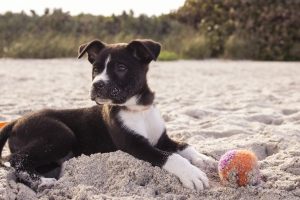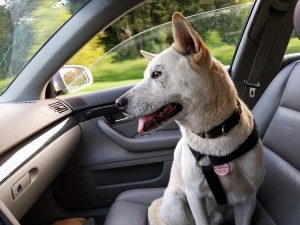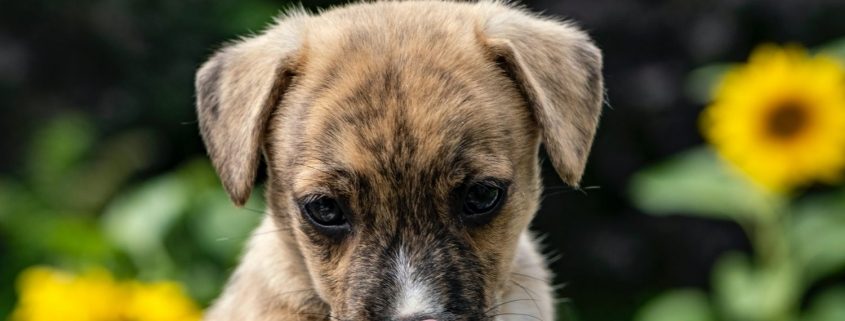Ask Crystal: Dog Socialization in a Socially Distant World

Dear Crystal,
We got our puppy (lab x standard poodle) during lockdown (in planning for 2yrs!) We did manage a short puppy obedience course and a couple of socialization sessions (without us – puppy dropped off) which he was good at. He can follow basic commands if no distractions. However, we’ve had hardly anyone at the house, and he gets so excited when he sees other dogs (people to a point) on walks etc., that all training goes out the window and he jumps, barks, lunges (no aggression). There’s no way he can be off lead as he just wouldn’t come back if others were around.
Is there anything you can suggest? Obviously, full lockdown again stops any chance of meetings.
Sincerely,
Lockdown Puppy
Dear Lockdown,
In some ways, social distancing can be a really good thing for some forms of socialization. Trainers often suggest working at a distance first and distance is built in at this time. Staying at a distance ensures that we can keep the dog under threshold and gently expose it to new stimuli. A lot of people misunderstand and think socialization is only about interacting with people but for some dogs that can be too overwhelming at first. Especially if you have a dog that leans towards the fearful side, exposing him to stimuli at a distance is the safest way to start socializing. Work towards developing self-confidence rather than flooding the dog with lots of people, noises and experiences.
Walk Tips
Taking a reactive dog for a walk can be a challenge. The area that you are walking in is important. It needs to have enough room to move far enough away from triggers. Streets that have cars, bushes or other visual barriers are helpful to use as visual blocks if another dog is within the threshold distance. Certain times of day tend to be busier, so choosing walk times that are less busy is important. There are often places to walk your dog such as school grounds after hours that have space to roam and where you will be unlikely to encounter his triggers or have enough space to keep him under threshold. You will find that you become very creative in finding quiet places to walk your dog.
Add in Structured Play
In addition, or in lieu of walks, you can add in structured play sessions, feeding enrichment and training. A well-balanced dog needs a combination of things to meet all his needs. These things will help tire him out while avoiding his triggers and practicing the behaviors you don’t like. Having excessive energy contributes to reactivity so being fulfilled and tired will help him to be easier to train new behaviors.
 Adding structured play into your dog’s exercise routine will provide an additional level of exercise with minimal effort on your part. Structured play means incorporating training into play sessions. When combining play and training, we are using the strong reinforcement of play with impulse control training. Impulse control helps your dog learn to wait patiently for the things they want. It also helps teach them to stay calm when exciting things happen. Some examples of structured play are two toy fetch, tug with rules, and flirt pole with rules.
Adding structured play into your dog’s exercise routine will provide an additional level of exercise with minimal effort on your part. Structured play means incorporating training into play sessions. When combining play and training, we are using the strong reinforcement of play with impulse control training. Impulse control helps your dog learn to wait patiently for the things they want. It also helps teach them to stay calm when exciting things happen. Some examples of structured play are two toy fetch, tug with rules, and flirt pole with rules.
Mental Stimulation
The easiest way to mentally stimulate a dog is through feeding exclusively with enrichment toys and/or scatter feeding. Dogs are scavengers by nature and finding food would normally take hours a day in the wild. Hide kibble in the grass or in various places in the yard or house. You can also start hiding kibble in boxes around the house or yard as the dog starts to get the hunting game. If you want to purchase feeding toys, there are many choices on the market, such as Kongs, Kong Wobblers, Gyros, etc.
Training is a great way to mentally stimulate your dog and work on skills that will be helpful in teaching him how to cope with his triggers. In addition to teaching skills, we can develop a desensitization and counterconditioning protocol to change the dog’s emotions surrounding his triggers. It can take time to change an animal’s emotions, so working on the coping skills first is recommended.
Attention is a critical first step in training the reactive dog. If you can keep the dog focused on you, then you can either move past the other dog or use distraction techniques. For this to work, you need to have the dog’s attention before it sees the trigger. Teach your dog an auto check-in so that they learn to check in with you every several seconds. To train this, stand inside with the dog on a leash and mark and treat any times the dog turns to look at you.
Trained Behaviors
It is important to have trained behaviors which help with management when unexpected encounters occur. Find It teaches the dog to search the ground for treats. If his nose is engaged and pointed down, he is less likely to notice his triggers. Many dogs really enjoy this game, so it may help to create a positive association with their triggers. The Emergency U-Turn is an escape cue to get the dog moving in the opposite direction in a fun, upbeat way.
Build up Frustration Tolerance
There are some cues that you can work on which will help teach your dog to build up their frustration tolerance. Wait at doorways and for food bowls is an easy behavior to teach and teaches the dog to wait for a moment before getting something they want. Leave It is a very useful cue that teaches a dog to leave something and come back to you.
Mostly you want to be working on his cues inside the home and outside near your home. Work on training in the backyard, front yard, driveway and then the street in front of the house. Places that are very familiar are usually less exciting and easier to get the dog to pay attention. If you are able to find quiet places to walk him, work on his training cues towards the end of the walk when he is more likely to be able to pay attention. Be sure to bring high value treats on your walks so the dog knows that treats are available on walks as well.
Reactivity
Reactivity is an emotional issue. It can be caused by fear or frustration. It sounds like you feel like it may be a frustration related behavior. I would suggest consulting a trainer to help you determine which it is because the treatment is going to vary based on the motivation. Frustration can be difficult to work with because the dog is so motivated to get to the trigger as opposed to fearful dogs that want to get away from the trigger.
Where to Start Training
It can be hard to determine where to start your training. Where can you stand with your puppy and just watch dogs and people without reacting? This is his threshold. He needs to stay under that threshold during training or you are just letting him practice the undesirable behavior and dogs are unable to learn new behaviors while over-threshold. If you have people walking on your street, can you stand in the open doorway with him without him reacting? Or further away from the door? Does he react to just the noise of other dogs? If so, then you need to work on desensitizing to noise first.
I have discovered that my new puppy leans towards fearful with new people. I decided to take him to a local park to gauge where his starting point was. I started in a grassy area away from all the people in the parking lot. He was happy and responding to cues until he saw people walking around from a distance and then he began alarm barking. I walked him further away until he stopped barking. When he looked at a person, I said “yes” and fed him a treat. This is an example of desensitization and counter conditioning. Desensitization means exposure to the trigger at a level the dog can tolerate without going over threshold. If he wanted to watch people walk around and wasn’t barking, I just let him sit and watch. Part of the training is letting the dog watch things and learn that those things aren’t coming to get them. But you have to keep them far enough away to make sure that is true.
You may be able to find a large park in your area to try a similar technique. Find a quiet spot away from the other dogs and reward him for calmly looking at the other dogs. Keep doing this over time and you should be able to move closer very slowly to the other dogs.
 You may find that car socialization is a good place to start with your puppy. Bring a second person along that can feed the puppy treats while you drive. If you have errands where you can take the dog with you without having to leave him in the car, bring him along. Take him to a supermarket and watch people walking around the parking lot from your car. Drive around city streets and let him watch people walking outside the window. Watching from a car usually feels safe for most dogs and you usually can see a lot of different types of things like bikers, skaters, strollers and different types of people.
You may find that car socialization is a good place to start with your puppy. Bring a second person along that can feed the puppy treats while you drive. If you have errands where you can take the dog with you without having to leave him in the car, bring him along. Take him to a supermarket and watch people walking around the parking lot from your car. Drive around city streets and let him watch people walking outside the window. Watching from a car usually feels safe for most dogs and you usually can see a lot of different types of things like bikers, skaters, strollers and different types of people.
At home socialization tips
Beyond exposure to the outside world, there is a lot of socialization work that we can do at home or in the areas around the home that work on a variety of stimuli exposure. We want to expose the puppy to anything that we need him to be able to deal with as an adult.
If you are telecommuting at the moment, take the time now to prepare your puppy for being alone during the day. Separation anxiety is much easier to prevent than treat so teach your dog that being alone is actually great. Set up a puppy zone like a crate, pen or confined area and give your puppy fun interactive feeding toys and treats while you leave the puppy in the puppy zone. Start by just going to a different room and work up to actually leaving the house and run an errand or take a walk. Start at short increments like 15 minutes and work your way up to longer time periods.
A dog needs to be able to calmly accept handling that it may experience in daily life. Think about each part of a vet exam or grooming session and include some form of that handling on a daily basis. Look in their ears, pick up their paws, look at their teeth, run your hands gently all over. Recreate the vet office by putting the puppy up on a counter or table and examining them. Each member of the family should spend time gently handling the puppy all over.
Play family dress up. Dig in the attic and pull out your hats, coats, canes, crutches, umbrellas, Halloween costumes. You can start by just placing the item on the floor for your puppy to explore. Feed treats or put food on the item as he checks it out. Then try wearing the object or moving it around. Always pair the presentation of the object it with food and let the dog check things out at his own pace.
Puppies also need to be exposed to different surfaces to walk on. Walk him around on different substrates in your yard such as pebbles, rocks, mulch, asphalt, grass, wet, dry surfaces. Pull out things from your kitchen or garage to walk on like fabric or cardboard.
Play household noises either at a lower volume or have the puppy stand farther away. You can also play recordings of thunder or fireworks on the computer at a low volume. Play videos of people with other types of voices and accents through your speakers so your puppy can hear other people speaking.
Reactivity is a difficult issue to work on at times. It takes some finesse to really be able to know a dog’s body language and to find the best technique for that dog. The good news is that he is a puppy, and he hasn’t had a lot of time to practice the behavior. His brain is also much more plastic than an adult dog so that makes his behavior easier to change. Hire a trainer now before it gets worse and hopefully it will not continue to be an issue into adulthood. Good luck and happy training!
Until next time,
Crystal







